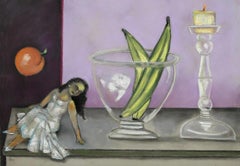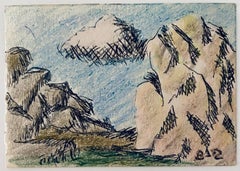Platinum Drawings and Watercolor Paintings
to
1
Overall Width
to
Overall Height
to
1
1
1
1
1
1
1
1
1
263
266
238
195
127
1
1
Style: Expressionist
Medium: Platinum
Aggressive Reflection, dreamlike still life female form expressive
Located in Brooklyn, NY
*ABOUT Stephen Basso
Stephen Basso's highly original pastels and oil paintings are romantic, yet thought provoking fantasies. His whimsical works are alive with boundless imagina...
Category
2010s Expressionist Platinum Drawings and Watercolor Paintings
Materials
Platinum
Related Items
Drawing, Pastel, Ink And Colored Pencils. "Free Spirits"
Located in Bogotá, Bogotá
Pastel, Pencil, petal flowers, Color and Ink on Paper.
The base of this drawing is Fabriano paper of 120g /m2. I use natural dyes of flowers, herbs, leaves, bark of trees as the fir...
Category
2010s Expressionist Platinum Drawings and Watercolor Paintings
Materials
Paper, Pastel, Ink, Pencil, Color Pencil
Pastel, Ink Drawing Rocks And Cloud Landscape Jewish American Modernist WPA
Located in Surfside, FL
Miniature Landscape
Provenance: Virginia Field, Arts administrator; New York, N.Y. Assistant director for Asia House gallery. (she was friends with John von Wicht and Andy Warhol)
Born in 1897, Ben-Zion Weinman...
Category
Mid-20th Century Expressionist Platinum Drawings and Watercolor Paintings
Materials
Pastel, Ink, Watercolor
PROFIL DE FEMME
Located in Aventura, FL
Original pencil and crayon drawing on paper. Hand signed and dated on front by the artist. Visible image size 25.6 x 19.7 in. Frame size approx 32.25 x 27 in. Artwork is in excellen...
Category
1950s Expressionist Platinum Drawings and Watercolor Paintings
Materials
Paper, Crayon, Pencil
Expressionist Color Drawing Cobalt Glass Vintage Frame Modernist Ben Zion WPA
Located in Surfside, FL
Expressionist ink and pastel crayon drawing of flowers in vase.
Framed in a vintage cobalt blue glass original frame
Hand signed and dated
Framed it measures 13.5 X 10.5
The actual ...
Category
1950s Expressionist Platinum Drawings and Watercolor Paintings
Materials
Paper, Oil Crayon, Pastel, Ink
$1,250
H 13.5 in W 10.5 in
Modernist Avant-Gard Figurative Abstract, Large-Scale Primary Colors Pastel
Located in Soquel, CA
Stunning modernist avant-garde figurative abstract pastel in deep royal blue, with red and yellow accents by Henry Elinson (Californian/Russian 1935-2010), 1996. Signed and dated "H....
Category
1960s Expressionist Platinum Drawings and Watercolor Paintings
Materials
Paper, Pastel
$2,520 Sale Price
34% Off
H 39.5 in W 51 in D 1.5 in
"Untitled" (2023) By Quang Ho, Original Charcoal Illustration
By Quang Ho
Located in Denver, CO
Quang Ho's "Untitled" (2023) is an original handmade charcoal drawing done on paper. This piece depicts an abstracted portrait of nude women.
Artist's Statement
"Realism and abstrac...
Category
20th Century Expressionist Platinum Drawings and Watercolor Paintings
Materials
Paper, Pastel
$3,500
H 38.25 in W 48.25 in
The First Day At School In Rural Wales Framed Welsh Cultural Pastel Artwork
Located in Sutton Poyntz, Dorset
Julian Ruddock.
British ( b.1965 ).
To School In Llanfihangel. (First Day At School).
Pastel On Paper.
Signed Lower Left.
Image size 21.7 inches x 29.6 inches ( 55cm x 75cm ).
Frame...
Category
Late 20th Century Expressionist Platinum Drawings and Watercolor Paintings
Materials
Paper, Pastel
$3,386
H 28.94 in W 36.82 in
Lost Hedgerows Framed Environmental Activism Pastel Artwork Late 20th Century
Located in Sutton Poyntz, Dorset
Julian Ruddock.
British ( b.1965 ).
Lost Hedgerows.
Pastel On Paper.
Signed Lower Right.
Image size 21.9 inches x 25 inches ( 55.5cm x 63.5cm ).
Frame size 29 inches x 32.1 inches ...
Category
Late 20th Century Expressionist Platinum Drawings and Watercolor Paintings
Materials
Paper, Pastel
$3,386
H 28.94 in W 32.09 in
Seated Pair, Framed Pastel on Paper by Francisco Zuniga
Located in Long Island City, NY
Artist: Francisco Zuniga, Costa Rican / Mexican (1912 - 1998)
Title: Seated Pair
Year: 1964
Medium: Pastel on Paper, signed and dated l.r.
Size: 15.5 x 25 inches
Frame: 24 x 33 inche...
Category
1960s Expressionist Platinum Drawings and Watercolor Paintings
Materials
Pastel
Expressionist Ink, Pastel, Crayon Drawing Jewish American Modernist Ben Zion WPA
Located in Surfside, FL
Expressionist ink and pastel crayon drawing of beans (carobs, flowers?) in pods
Hand signed.
Born in 1897, Ben-Zion Weinman celebrated his European Jewish heritage in his visual wo...
Category
Mid-20th Century Expressionist Platinum Drawings and Watercolor Paintings
Materials
Paper, Oil Crayon, Pastel, Ink
The Secret Ladder - Original Pencil and Pastel on Paper - 1880s
Located in Roma, IT
The Secret Ladder is an original modern artwork realized in the Second half of the XIX Century by a French Artist.
Original pencil drawing and colore pastels on ivory paper.
Passep...
Category
1880s Expressionist Platinum Drawings and Watercolor Paintings
Materials
Pencil, Pastel
$308
H 5.52 in W 9.06 in D 0.04 in
Clown
Located in Astoria, NY
Nahum Tschacbasov (Russian/American, 1899-1984), Clown, Pastel on Paper, 1950, signed and dated lower left, painted wood frame. Image: 11.5" H x 7.5" W; frame: 18" H x 14" W. Provena...
Category
1950s Expressionist Platinum Drawings and Watercolor Paintings
Materials
Paper, Pastel
Platinum drawings and watercolor paintings for sale on 1stDibs.
Find a wide variety of authentic Platinum drawings and watercolor paintings available on 1stDibs. While artists have worked in this medium across a range of time periods, art made with this material during the 21st Century is especially popular. There are many well-known artists whose body of work includes ceramic sculptures. Popular artists on 1stDibs associated with pieces like this include and Stephen Basso. Frequently made by artists working in the Expressionist, Photorealist, all of these pieces for sale are unique and many will draw the attention of guests in your home. Not every interior allows for large Platinum drawings and watercolor paintings, so small editions measuring 0.1 inches across are also available Prices for drawings and watercolor paintings made by famous or emerging artists can differ depending on medium, time period and other attributes. On 1stDibs, the price for these items starts at $1 and tops out at $1,595,000, while the average work can sell for $893.

